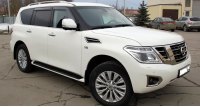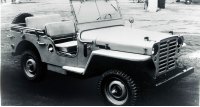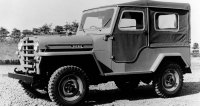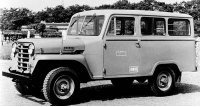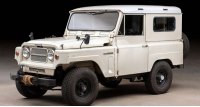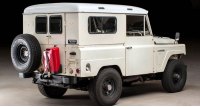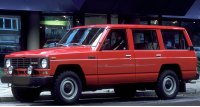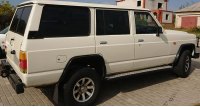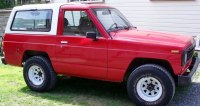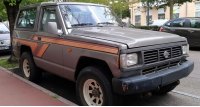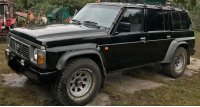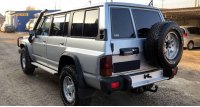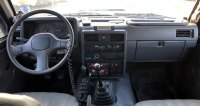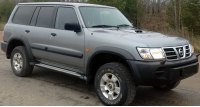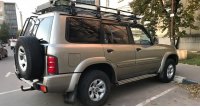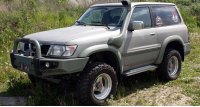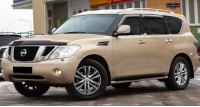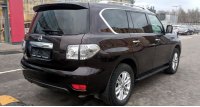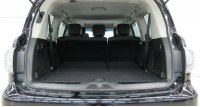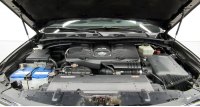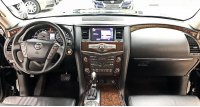The main competitors and classmates of this car are Audi Q7, BMW X6, Chevrolet Tahoe, Infiniti QX80, Lexus GX, Mercedes-Benz G-Class, Mitsubishi Pajero, Porsche Cayenne, Toyota Land Cruiser, Range Rover and Volvo XC90.
First generation (4W60, 1951−1960)
In September 1951 in all car dealerships «Nissan» an SUV appeared with a code «4W60», superficially very similar to «Willys Jeep». The body was a 3-door station wagon or a 2-door pickup truck 3650 mm long, 1740 mm wide, 1720 mm high and curb weight 1500 kg. The engine was located longitudinally in front, the drive was connected full to all wheels. The engine was first installed with a 6-cylinder in-line 3.7-liter, model «NAK» had a power of 75 hp. Transmission 4-speed manual.
In August 1955, a modification of the car was presented «Patrol» with code «4W61». Changed the windshield, which became one-piece, grille, added more chrome to the exterior and unequal-sized seats (passenger side is wider than driver side). The grille badge was chromed with red color and lettering «NISSAN». The engine remained the same volume of 3.7 liters, but it was seriously improved - a model appeared «NB» 92 hp. A 4.0-liter 6-cylinder in-line engine also appeared (3956 cm3), model «NC» 105 hp
In October 1958, the following modification appeared with the code «4W65». The radiator grille has become completely chrome-plated, the front fenders and the hood have been changed. Wagon body appeared «WG4W65» capacity for eight people. In December 1959, a modification appeared «4W66», the main difference of which from its predecessors was the use of a 6-cylinder in-line gasoline engine with a volume of 4.0 liters (3956 cm3), modification «P» 125 hp
In 1950 appeared «Nissan 4W70 Carrier» on base chassis «Dodge M37», but with transmission from «4W60». It was a truck for bad road conditions. Later there were modifications «4W72» And «4W73» with engine «P» 135 hp
Second generation (60, 1960−1980)
In 1960, the second generation began to be sold in Australia with the name «Nissan Patrol 60». It was a two-door soft-top body with a short (2200 mm) and regular (2500 mm) wheelbase. There were also models «H60» with extended wheelbase (2800 mm) with seating for eight passengers. The suspension was spring, drum brakes. Left hand drive modifications with code «L60/GL60» sold later outside of Australia. In the United States, the car began to be delivered only in 1962 through dealerships «Datsun» and finished in 1969.
The engine was installed 6-cylinder in-line gasoline with a volume of 4.0 liters (3956 cm3), modification «P» 145 hp. The gearbox was a 3-speed manual «F3B83L», and then 4-speed. Also a two-stage transfer case with all-wheel drive.
In 1963, a hard top body appeared (models «KG60» And «KGL60»), which looked like «Toyota Land Cruiser».
In 1960, the Indian Army showed interest in two vehicles based on «Nissan» — «Patrol P60» And «Nissan 4W73». Based on them, a car was developed with the name «Jonga» (reduction from «Jabalpur Ordinance aNd Guncarriage Assembly «, that is, the place where the car was assembled). In 1965, its production began, which continued until 1999.
Third generation (160, 1980–1989)
Third generation with code «160» appeared in 1960. The body was produced 3-door with soft and hard top, 5-door station wagon, 2- and 4-door pickup truck, as well as a fire truck. The entire suspension was spring. Rear wheel drive with front wheel drive. Various finishes and colors are available. At the highest trim levels, hydraulic power steering and air conditioning were available. The car was assembled in Japan, Iran, Spain and South Africa.
The gearbox was a mechanical 4-speed, and on a chassis with an extended wheelbase and engine «L28» optionally installed a 3-speed automatic. All cars were equipped with a two-speed transfer case with a 1:1 normal gear and a low gear. The front differential on all models was «C200». Optionally, a differential with increased internal resistance was installed. Heavy rear differential «H260» was used in some pickup trucks and station wagons with an engine «P40». On models for the European market, a light differential was installed at the rear «C200».
The range of petrol engines includes three 2.4-liter models (2389 cm3, Z24, I4, 103 hp), 2.8 liters (2753 cm3, L28/L28E, I6, 133 hp) and 4.0 liters (3956 cm3, P40, I6, 143 hp). There were 2 diesel engines, both six-cylinder in-line engines with a volume of 3.3 liters (3245 cm3) — «SD33» 81 hp and terribly «SD33T» 110 hp
In 1983, the car was updated. The appearance of the front end was changed, the front suspension was upgraded, a high roof was added «Super Roof», and also modified the gearbox and engines.
In 1984, the company abandoned the brand «Datsun» and it was the last year when you could buy «Datsun Patrol».
Series 260 (1986–2002)
car with code «260» was the version «160», featuring rectangular headlights, produced in Spain (Rome and Barcelona) company «Nissan Ibérica» from 1986 to 2002 and was called «Ebro Patrol». For all the time, two 2.4-liter gasoline engines were installed (2389 cm3, Z24, I4, 103 hp) and 2.8 liters (2753 cm3, L28/L28E, I6, 133 hp). Diesel engines were five models of 2.7 liters (2702 cm3, Perkins MD27, I4, 59 hp), 2.8 liters (2825 cm3, RD28, I6, 99 hp), 2.8 liters (2825 cm3, RD28T, I6, turbo, 125 hp), 3.3 liters (3245 cm3, SD33, I6, 81 hp) and 3.3 liters (3245 cm3, SD33T, I6, turbo, 110 hp).
Fourth generation (Y60, 1987–1997)
Fourth generation production with code «Y60» started in 1987. The new car was mechanically radically different from its predecessors. From the middle class, it has become a full-size SUV, which will continue to be classified. Springs began to be used in the suspension instead of springs, which greatly improved comfort. A three-link suspension was installed in front, anti-roll bars appeared. The wheelbase was short (SWB, 2400 mm) and elongated (LWB, 2970 mm). Body length SWB was 4285 mm, LWB: 4845 mm, width 1930 mm, height 1815 mm. The car had different trim levels, designated differently in different countries, for example «SLX», «LX».
The front brakes were disc, rear - disc and drum. Hydraulic power steering was on all cars in the database. For the first time, they began to equip the rear speed with a synchronizer in the gearbox. Most models were equipped with a differential with increased internal resistance, and the rest with a vacuum or electric solenoid that controlled the rear differential lock. Some models were equipped with an engine-driven winch and control from the cab. The car was also sold many off-road accessories by official dealers.
Gasoline engines had two models of the following characteristics - 3.0 liters (2962 cm3, RB30S, I6, 134 hp) and 4.2 liters (4169 cm3, TB42S/TB42E, I6, 173 hp). There were also two 2.8-liter diesel engines (2825 cm3, RD28T, I6, turbo, 183 hp) and 4.2 liters (4169 cm3, TD422, I6, 123 hp). The gearbox was installed 4-speed automatic «RE4R03A», as well as 5-speed mechanical «FS5R50A» or «FS5R30A».
In 1992 and 1995, they carried out major updates to the car, which affected the appearance, interior, engines and transmission.
Fifth generation (Y61, 1997–2013)
In December 1997, the fifth generation appeared «Patrol» with factory code «Y61». The car was presented at the International Motor Show in Frankfurt. The body was in the form of a 3 and 5 door wagon or 2 and 4 door pickup. The wheelbase remained the same length and the total length of the car was 5080 mm, width 1940 mm, height 1855 mm and a curb weight of 2473 kg. The engine was located longitudinally in front, the drive was carried out on the rear wheels, the front-wheel drive is connected rigidly only to overcome impassability. Assembly facilities were located in Japan, Morocco, Pakistan, South Africa and Spain.
Gasoline engines installed two models with a volume of 4.5 liters (4479 cm3, TB45E, I6, 197 hp) and 4.8 liters (4759 cm3, TB48DE, I6, 245 hp). Diesel engines were four models with a volume of 2.8 liters (2825 cm3, RD28ETi, I6, 133 hp), 3.0 liters (2953 cm3, ZD30DDTi, I4, 158 hp), 4.2 liters (4169 cm3, TD422, I6, 145 hp) and 4.2 liters (4169 cm3, TD42T3, I6, 160 hp). Gearbox 4-speed «RE4R03A» or 5 speed «RE5R05A» automatic as well as 5-speed manual «FS5R30A» or «FS5R50B».
In 2005, an updated version of the car was released «Y61». The headlights were updated, reflectors appeared on the body protection elements, enlarged taillights, engine problems were fixed «ZD30». Sales «Nissan Safari» were stopped in the Japanese market due to poor sales. In 2014, the production of the fifth generation was stopped in favor of the sixth, but assembly is still ongoing in South Africa, Pakistan, the Middle East, the Philippines and some other countries.
Sixth generation (Y62, 2010–present time)
All-new sixth generation with code «Y62» was presented in the city of Abu Dhabi in February 2010. The body is available only as a 5-door SUV on the platform «Nissan F-Alpha», that is, a body on a supporting frame. The car is 5140 mm long, 1995 mm wide, 1940 mm high and curb weight 2695-2795 kg, that is, the external dimensions have increased compared to its predecessor. Rear-wheel drive with all-wheel drive for poor road conditions. You can choose from four modes: sand, road, rocks and snow. The car was assembled in Japan, Malaysia and Nigeria.
As of 2017, the car was equipped with one 4.0-liter six-cylinder V-twin gasoline engine (3954 cm3, VQ40DE, V6, 275 hp), as well as two eight-cylinder V-shaped engines with a volume of 5.6 liters (5552 cm3), code «VK56VD» 400 hp. And «VK56DE» 320 hp. Gearbox 6-speed manual, as well as two automatic, 5 or 7-speed.
Deluxe version with code «Z62» sold in North America as «Infiniti QX56», which was later renamed in 2013 to «Infiniti QX80». regular version «Y6» went on sale in the US in 2016 under the name «Armada».
In 2014, a rather strong update was carried out. Changed taillights, all headlights are LED. The interior and rims have also been updated.
